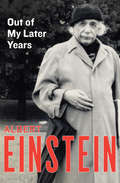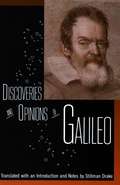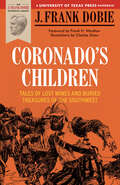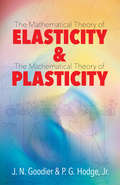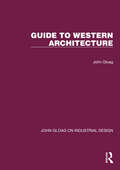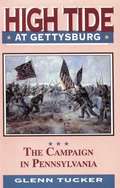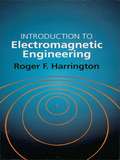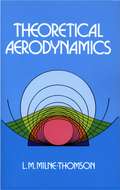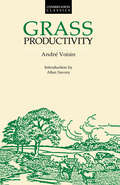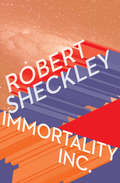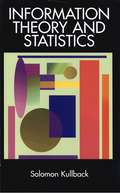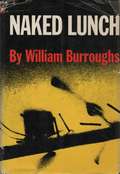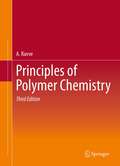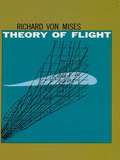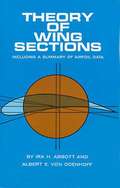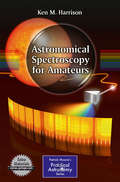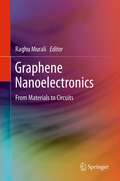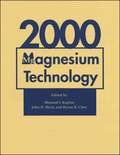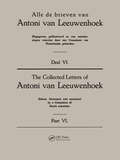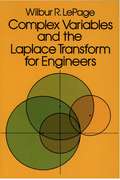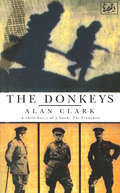- Table View
- List View
Out of My Later Years: The Scientist, Philosopher, and Man Portrayed Through His Own Words
by Albert EinsteinAn inspiring collection of essays, in which Albert Einstein addresses the topics that fascinated him as a scientist, philosopher, and humanitarian Divided by subject matter—&“Science,&” &“Convictions and Beliefs,&” &“Public Affairs,&” etc.—these essays consider everything from the need for a &“supranational&” governing body to control war in the atomic age to freedom in research and education to Jewish history and Zionism to explanations of the physics and scientific thought that brought Albert Einstein world recognition. Throughout, Einstein&’s clear, eloquent voice presents an idealist&’s vision and relays complex theories to the layperson. Einstein&’s essays share his philosophical beliefs, scientific reasoning, and hopes for a brighter future, and show how one of the greatest minds of all time fully engaged with the changing world around him. This authorized ebook features rare photos and never-before-seen documents from the Albert Einstein Archives at the Hebrew University of Jerusalem.
A Practical Guide to Single Storey House Extensions
by Andrew R. WilliamsA guide to tackling the problems experienced in a project of this nature relevant to planning and building control procedures.
Stowaway to the Mushroom Planet
by Eleanor CameronDoes anyone but Chuck Masterson and David Topman and Mr. Bass know about the Mushroom Planet? Well, there's Mr. Tyco Bass's cousin, Mr. Theo. He is a Mushroom Person, like Mr. Tyco, so he knows. And of course David and Chuck told their families about THE WONDERFUL FLIGHT TO THE MUSHROOM PLANET (along with a good many thousands of readers). But what if just an ordinary human being should happen to find out about it? Would it ruin everything? The answer is in this second story about Basidium, the small planet which can only be seen when Tyco Bass's special filter is affixed to the telescope. David and Chuck, returning to Basidium in their new space ship, have considerable difficulty carrying out Mr. Bass's wish that the planet be kept a dead secret. One Horatio Q. Peabody makes this trip even more of an adventure than the first one.
Discoveries and Opinions of Galileo
by Galileo GalileiDirecting his polemics against the pedantry of his time, Galileo, as his own popularizer, addressed his writings to contemporary laymen. His support of Copernican cosmology, against the Church's strong opposition, his development of a telescope, and his unorthodox opinions as a philosopher of science were the central concerns of his career and the subjects of four of his most important writings. Drake's introductory essay place them in their biographical and historical context. Translation and notes by Stillman Drake
Coronado's Children: Tales of Lost Mines and Buried Treasures of the Southwest (Barker Texas History Center Series)
by J. Frank DobieWritten in 1930, Coronado's Children was one of J. Frank Dobie's first books, and the one that helped gain him national prominence as a folklorist. In it, he recounts the tales and legends of those hardy souls who searched for buried treasure in the Southwest following in the footsteps of that earlier gold seeker, the Spaniard Coronado. "These people," Dobie writes in his introduction, "no matter what language they speak, are truly Coronado's inheritors. . . . l have called them Coronado's children. They follow Spanish trails, buffalo trails, cow trails, they dig where there are no trails; but oftener than they dig or prospect they just sit and tell stories of lost mines, of buried bullion by the jack load. . . " This is the tale-spinning Dobie at his best, dealing with subjects as irresistible as ghost stories and haunted houses.
Elasticity and Plasticity: The Mathematical Theory of Elasticity and The Mathematical Theory of Plasticity (Dover Books on Mathematics)
by J. N. Goodier P. G. Hodge Jr.This volume comprises two classic essays on the mathematical theories of elasticity and plasticity by authorities in this area of engineering science. Undergraduate and graduate students in engineering as well as professional engineers will find these works excellent texts and references. The Mathematical Theory of Elasticity covers plane stress and plane strain in the isotropic medium, holes and fillets of assignable shapes, approximate conformal mapping, reinforcement of holes, mixed boundary value problems, the third fundamental problem in two dimensions, eigensolutions for plane and axisymmetric states, anisotropic elasticity, thermal stress, elastic waves induced by thermal shock, three-dimensional contact problems, wave propagation, traveling loads and sources of disturbance, diffraction, and pulse propagation. The Mathematical Theory of Plasticity explores the theory of perfectly plastic solids, the theory of strain-hardening plastic solids, piecewise linear plasticity, minimum principles of plasticity, bending of a circular plate, and other problems.
Guide to Western Architecture
by John GloagOriginally published in 1958, A Guide to Western Architecture charts the origins of the system of architectural design that was perfected in Greece, follows its development under the Roman Empire and describes the achievements of the Byzantine architects. Passing through Romanesque to Gothic, the contributions made by Mediaeval builders to structure and design are recorded, and then the impact of the Renaissance on architecture, and its characteristic development in the different European countries. The transplanting of Renaissance ideas to the New World is covered, and finally the origins and nature of the new Western architecture occupy the last section of the book. The Appendix includes a list of the principal architects, and brief notes on their work, from the 5th century B. C. to the end of the Renaissance.
High Tide at Gettysburg: The Campaign in Pennsylvania
by Glenn TuckerThe author tries to present how the Gettysburg battle was won and lost, and why the Gettysburg campaign remains such an appealing study to large numbers even after the passing of nearly a century.
The Human Condition
by Hannah ArendtA work of striking originality bursting with unexpected insights, "The Human Condition" is in many respects more relevant now than when it first appeared in 1958. In her study of the state of modern humanity, Hannah Arendt considers humankind from the perspective of the actions of which it is capable. The problems Arendt identified then --- diminishing human agency and political freedom, the paradox that as human powers increase through technological and humanistic inquiry, we are less equipped to control the consequences of our actions --- continue to confront us today.
Introduction to Electromagnetic Engineering (Dover Books on Electrical Engineering)
by Roger E. HarringtonThis study of electromagnetic theory introduces students to a broad range of quantities and concepts, imparting the necessary vector analysis and associated mathematics and reinforcing its teachings with several elementary field problems. Based on circuit theory rather than on the classical force-relationship approach, the text uses the theory of electric circuits to provide a system of experiments already familiar to the electrical engineer; a series of field concepts are then introduced as a logical extension of circuit theory. Virtually unobtainable elsewhere, this text was written by a prominent professor whose recognition includes the prestigious IEEE Electromagnetics Award. It is appropriate for advanced undergraduate and graduate students with a background in calculus and circuit theory. 176 Figures. 9 Tables.
Theoretical Aerodynamics
by L. M. Milne-ThomsonA classic in its field, this university text and reference book has long been one of the basic works. This is the complete reprinting of the revised (1966) edition which brings the subject up to date, including a complete and probably unique chapter on conical flow round sweptback wings.After two introductory chapters on the simplifying assumptions demanded for the study and a final chapter on vectors, the author treats the material in four fairly well-defined parts: (1) two-dimensional aerofoils (two-dimensional motion, rectilinear vortices, the circular cylinder as an aerofoil, Joukowski's transformation, theory of two-dimensional aerofoils, and thin aerofoils); (2) three-dimensional aerofoils (induced velocity, aerofoils of finite aspect ratio, the lifting line theory, lifting surface theory, propellers, and wind tunnel corrections); (3) subsonic and supersonic flow (subsonic flow, supersonic flow, supersonic sweptback and delta wings); and, (4) the aircraft as a whole (simple flight problems, moments, and stability). The treatment is founded on complex variable and vector methods, both of which are explained in the self-contained text. A wealth of problems, illustrations, and cross-references add to the book's value both as a text and a reference. The only prerequisite is a knowledge of the elements of the differential and integral calculus.
Grass Productivity: An Introduction To Rational Grazing (Conservation Classics Ser.)
by Allan Savory Philosophical Library Pub. Andre VoisinGrass Productivity is a prodigiously documented textbook of scientific information concerning every aspect of management "where the cow and grass meet." Andre Voisin's "rational grazing" method maximizes productivity in both grass and cattle operations.
Immortality Inc.
by Robert SheckleyA man wakes up after a fatal car accident—in someone else&’s body—in this ahead-of-its-time Hugo Award–nominated classic. Thomas Blaine remembered the car accident that killed him—and then he woke up in the hospital. A nurse told him where he was. &“You&’d call it being in the future.&” A future where bodies are sold to the highest bidder as new homes for the minds of the rich, who are greedy for more life when their own bodies wear out or are damaged. Suddenly, keeping body and soul together has taken on a new, and very sinister, meaning. From the very beginning of his career, Robert Sheckley was recognized by fans, reviewers, and fellow authors as a master storyteller and the wittiest satirist working in the science fiction field. Open Road is proud to republish his acclaimed body of work, with nearly thirty volumes of full-length fiction and short story collections. Rediscover, or discover for the first time, a master of science fiction who, according to the New York Times, was &“a precursor to Douglas Adams.&”
Information Theory and Statistics
by Solomon KullbackHighly useful text studies logarithmic measures of information and their application to testing statistical hypotheses. Includes numerous worked examples and problems. References. Glossary. Appendix. 1968 2nd, revised edition.
Naked Lunch
by William S. BurroughsDelirious, nonlinear ravings of a junkie in hell. Also includes excerpts from the Boston trial where it was declared not obscene in 1966.
Principles of Polymer Chemistry
by A. RavveThis successful textbook undergoes a change of character in the third edition. Where earlier editions covered organic polymer chemistry, the third edition covers both physical and organic chemistry. Thus kinetics and thermodynamics of polymerization reactions are discussed. This edition is also distinct from all other polymer textbooks because of its coverage of such currently hot topics as photonic polymers, electricity conducting polymers, polymeric materials for immobilization of reagents and drug release, organic solar cells, organic light emitting diodes. This textbook contains review questions at the end of every chapter, references for further reading, and numerous examples of commercially important processes.
Theory of Flight
by Richard Von Mises"An outstanding textbook." -- Scientific, Medical and Technical BooksAlmost unsurpassed as a balanced, well-written account of fundamental fluid dynamics, Theory of Flight may still be recommended for a clearer presentation than is to be forced in many more recent works, though it is limited to situations in which air compressibility effects are unimportant.Designed for the college senior or beginning graduate student, the text assumes a knowledge of the principles of calculus and some training in general mechanics. It is unusual in offering a well-balanced introduction, stressing equally theory and practice. It avoids the formidable mathematical structure of fluid dynamics, while conveying by often unorthodox methods a full understanding of the physical phenomena and mathematical concepts of aeronautical engineering. Theory of Flight contains perhaps the best introduction to the general theory of stability, while the introduction to dynamics of incompressible fluids and the chapters on wing theory remain particularly valuable for their clarity of exposition and originality of thought.Mises' position as one of the great pioneers in the development of the aeronautical sciences lends a flavor of authenticity not found in more conventional textbooks. Any student who has made himself familiar with his exposition of the fundamentals and applications will have acquired an excellent background for additional, more specialized fields of modern aeronautical engineering.
Theory of Wing Sections: Including a Summary of Airfoil Data
by Ira H. Abbott A. E. Doenhoff"Most useful in working with wing sections and methods for using section data to predict wing characteristics . . . much detailed geometric and aerodynamic data." -- Mechanical EngineeringThe first edition of this work has been corrected and republished in answer to the continuing demand for a concise compilation of the subsonic aerodynamics characteristics of modern NASA wing sections together with a description of their geometry and associated theory. These wing sections, or their derivatives, continue to be the ones most commonly used for airplanes designed for both subsonic and supersonic speeds, and for helicopter rotor blades, propeller blades, and high performance fans.Intended to be primarily a reference work for engineers and students, the book devotes over 300 pages to theoretical and experimental considerations. The theoretical treatment progresses from elementary considerations to methods used for the design of NACA low-drag airfoils. Methods and data are presented for using wingsection data to predict wing characteristics, and judiciously selected plots and cross-plots of experimental data are presented for readily useful correlation of certain simplifying assumptions made in the analyses. The chapters on theory of thin wings and airfoils are particularly valuable, as is the complete summary of the NACA's experimental observations and system of constructing families of airfoils. Mathematics has been kept to a minimum, but it is assumed that the reader has a knowledge of differential and integral calculus, and elementary mechanics.The appendix of over 350 pages contains these tables: Basic Thickness Forms, Mean Lines, Airfoil Ordinates, and Aerodynamic Characteristics of Wing Sections.
Astronomical Spectroscopy for Amateurs (The Patrick Moore Practical Astronomy Series)
by Ken M. HarrisonAstronomical Spectroscopy for Amateurs is a complete guide for amateur astronomers who are looking for a new challenge. After a brief overview of the development of spectroscopes and an introduction to the theory of stellar spectra, the book goes on to examine the various types of spectroscopes available to amateurs. Next, practical sections address all aspects of setting-up and using various types of commercially-available and home-built spectroscopes. A final part gives detailed instructions for the design and construction of three different spectroscopes, along with the necessary design theory (minimal math). The home-made spectroscopes have performance capabilities near or equal to commercial units but are constructed using basic hand tools for a fraction of the cost! This up-to-date practical spectroscopy book will enable amateur astronomers to develop the skills and equipment needed to prepare scientifically acceptable spectra data, and to make a valuable contribution to ProAm projects.
Graphene Nanoelectronics
by Raghu MuraliGraphene has emerged as a potential candidate to replace traditional CMOS for a number of electronic applications; this book presents the latest advances in graphene nanoelectronics and the potential benefits of using graphene in a wide variety of electronic applications. The book also provides details on various methods to grow graphene, including epitaxial, CVD, and chemical methods. This book serves as a spring-board for anyone trying to start working on graphene. The book is also suitable to experts who wish to update themselves with the latest findings in the field.
Magnesium Technology 2000
by Byron B. Clow Howard I. Kaplan John N. HrynThese proceedings provide an overview of magnesium production technology, mechanical properties, corrosion resistance, and alloy development. Co-sponsored with TMS by the Magnesium Association, the symposium was divided into several sessions: Electrolytic technology, thermal reduction/environmental, automotive issues and recycling, alloy development/corrosion, solidification, creep properties/heat treating effects, physical/mechanical properties, wrought alloys/thixmolding.A collection of papers from the 2000 TMS Annual Meeting & Exhibition, held in Nashville, Tennessee, March 12-March 15, 2000.
Pasteur and Modern Science
by Rene DubosThis is a fresh account of the extraordinary life of Louis Pasteur, and the monumental impact he had on biochemistry, microbiology, bacteriology and immunology.
Collected Letters Van Leeuwenhoek, Volume 6
by A Commission of Dutch scientists.This 6th volume in a 19-volume series contains 21 letters written by van Leeuwenhoek of the perod 1686-87. The contents of the letters published here, again show the great range of subjects that occupied Van Leeuwenhoek: from sugar candy, the shape and crystal structure of diamonds, the dissolution of silver crystals in aqua fortis to gold dust from Guinea dissolved in aqua regia and the dissolution and separation of gold, silver, and copper. Every volume in the Series contains the texts in the original Dutch and an English translation. The great range of subjects studied by Van Leeuwenhoek is reflected in these letters: instruments to measure water, pulmonary diseases; experiments relating to the solution of gold and silver; salt crystals and grains of sand; botanical work, such as duckweed and germination of orange pips; description on protozoa. blood, spermatozoa and health and hygiene, for example and harmfulness of tea and coffee and the benefits of cleaning teeth.
Complex Variables and the Laplace Transform for Engineers
by Wilbur R. Lepage"An excellent text; the best I have found on the subject." -- J. B. Sevart, Department of Mechanical Engineering, University of Wichita"An extremely useful textbook for both formal classes and for self-study." -- Society for Industrial and Applied MathematicsEngineers often do not have time to take a course in complex variable theory as undergraduates, yet is is one of the most important and useful branches of mathematics, with many applications in engineering. This text is designed to remedy that need by supplying graduate engineering students (especially electrical engineering) with a course in the basic theory of complex variables, which in turn is essential to the understanding of transform theory. Presupposing a good knowledge of calculus, the book deals lucidly and rigorously with important mathematical concepts, striking an ideal balance between purely mathematical treatments that are too general for the engineer, and books of applied engineering which may fail to stress significant mathematical ideas.The text is divided into two basic parts: The first part (Chapters 1-7) is devoted to the theory of complex variables and begins with an outline of the structure of system analysis and an explanation of basic mathematical and engineering terms. Chapter 2 treats the foundation of the theory of a complex variable, centered around the Cauchy-Riemann equations. The next three chapters -- conformal mapping, complex integration, and infinite series -- lead up to a particularly important chapter on multivalued functions, explaining the concepts of stability, branch points, and riemann surfaces. Numerous diagrams illustrate the physical applications of the mathematical concepts involved.The second part (Chapters 8-16) covers Fourier and Laplace transform theory and some of its applications in engineering, beginning with a chapter on real integrals. Three important chapters follow on the Fourier integral, the Laplace integral (one-sided and two-sided) and convolution integrals. After a chapter on additional properties of the Laplace integral, the book ends with four chapters (13-16) on the application of transform theory to the solution of ordinary linear integrodifferential equations with constant coefficients, impulse functions, periodic functions, and the increasingly important Z transform. Dr. LePage's book is unique in its coverage of an unusually broad range of topics difficult to find in a single volume, while at the same time stressing fundamental concepts, careful attention to details and correct use of terminology. An extensive selection of interesting and valuable problems follows each chapter, and an excellent bibliography recommends further reading. Ideal for home study or as the nucleus of a graduate course, this useful, practical, and popular (8 printings in its hardcover edition) text offers students, engineers, and researchers a careful, thorough grounding in the math essential to many areas of engineering. "An outstanding job." -- American Mathematical Monthly
The Donkeys
by Alan ClarkThe landmark exposé of incompetent leadership on the Western Front - why the British troops were lions led by donkeys On 26 September 1915, twelve British battalions – a strength of almost 10,000 men – were ordered to attack German positions in France. In the three-and-a-half hours of the battle, they sustained 8,246 casualties. The Germans suffered no casualties at all. Why did the British Army fail so spectacularly? What can be said of the leadership of generals? And most importantly, could it have all been prevented? In The Donkeys, eminent military historian Alan Clark scrutinises the major battles of that fateful year and casts a steady and revealing light on those in High Command - French, Rawlinson, Watson and Haig among them - whose orders resulted in the virtual destruction of the old professional British Army. Clark paints a vivid and convincing picture of how brave soldiers, the lions, were essentially sent to their deaths by incompetent and indifferent officers – the donkeys. ‘An eloquent and painful book... Clark leaves the impression that vanity and stupidity were the main ingredients of the massacres of 1915. He writes searingly and unforgettably’ Evening Standard
